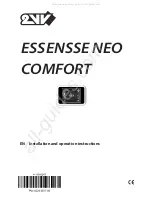
⑤
Make sure the indoor unit will not be powered off arbitrarily. Otherwise other
indoor units that are in the same system will not function normally (poor
cooling, malfunction of lack of indoor unit).
⑥
Normal working conditions for controller:
a. Temperature: -20
~
+60
℃
.
b. Humidity: less than 85%,
except frosting.
c. Location: indoor (it is highly recommended to install this product in the
electric control cabinet), not subject to direct sunlight, rain and snow etc.
2) Power Supply
①
Installation must be performed by professional personnel. Improper
installation may result in fire hazard or electric shock.
②
Do not insert the power plug into a power socket until you make sure it is dry
and clean.
③
Before touching the electric components, make sure the device is power-off.
④
Never touch the device with wet hands, otherwise electric shock may occur.
⑤
Power cord of stated specification must be used. Poor contact or improper
installation may lead to fire hazard.
⑥
If power cord is connected inversely or the input power is out of the allowable
range, it may lead to fire hazard or even cause damage to the device.
3) Communication
①
Make sure the communication cables are connected to correct ports,
otherwise communication error will occur.
②
After the circuit is connected, use insulated adhesive bandage to protect the
circuit from oxidation and short circuit.
4) Debugging
①
If main board of outdoor unit needs to be replaced, each DIP switch of the
new main board must be the same with that of the original board.
②
If KWH meter needs to be replaced, the code of the new KWH meter must be
different from that of the original KWH meter.
③
To ensure accurate billing, prohibit cutting off the power supply of KWH meter.
Otherwise, it may lead to abnormal calculation of electricity
④
If main board of indoor unit needs to be replaced, the project code of the new
main board must be the same with that of the original board.





































